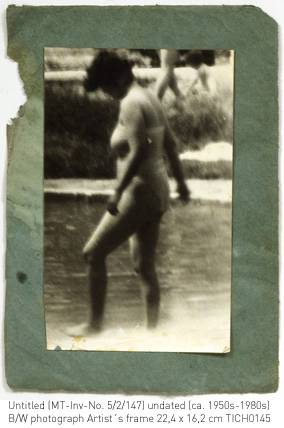Miroslav Tichý
25 Jun - 08 Aug 2005
Arndt & Partner Berlin are delighted to announce their first solo exhibition with Miroslav Tichý.
In his photographs the Czech artist renders a whole universe of female figures. He captures women strolling through the city, sunbathing by the swimming pool, chatting with neighbours, or going shopping. Other women are photographed from the TV screen. Sometimes they are unaware of the observer, sometimes unopposed, sometimes angry. Their ankles, faces and torsos dominate the composition. In a nearly obsessive manner he takes close to one hundred photographs a day, equipped with archaicly looking instruments that turn out to be self-made cameras. Build from scraps, such as metal plates, crown caps, rubber bands, cardboard, scotch tape, and plexi glass, his awkward yet masterful cameras display an ingenious inventiveness.
In the mid 1940s Miroslav Tichý attends the Academy of Arts in Prague, where he concentrates on drawing and painting. His early works are distinctively influenced by Expressionism. After the communist overthrow in 1948 the young and promising world of the artist begins to tremble. Not willing to subordinate himself to the political system and follow the dicdates of Socialist Realism, he soon becomes an outsider. Noticeably he fails to cope with the depression under the communist system – his resistance however never ceases. In opposition to the total integration of the individual into the ideologically tightly strucured society he reponds with the negation of their social values. In the 1960s Miroslav Tichý, who is the son of a gentlemen’s tailor, begins to neglect his appearance to such an extent, that his clothes fall from his body in rags. In his small home town he is increasingly being avoided as a derelict critic of the system. During this period he begins his photographic expeditions.
The artist’s tireless capturing of his immediate environment seems like an attempt to get a grip on a reality from which he has withdrawn and that is now rejecting him in return. In allusion to Plato’s cave allegory, he regards the world as mere reflection and himself as its only conscious observer. Often Miroslav Tichý applies intricate pencil drawings onto the surface of his photographs and frames them with sensitively designed passepartouts, thus enhancing their profound poetry. Due to the yearlong storage in his run-down house, a melancholic veil of stains has layered itself upon the photographs. Miroslav Tichý works inhere an enigmatic and translucent atmosphere. In the mid 1980s the artist decides to give up artistic production: ‘I had a norm. One hundred photographs a day. (...) When I reached my norm, I stopped.’
Miroslav Tichý was born in 1926 in Brno, Czech Republic, where he still lives. Shortly after his photographs were first exhibited in the Biennial of Sevilla, Spain, curated by Harald Szeemann, he acclaimed world wide recognition. From 15 July to 18 September the Kunsthaus Zurich, Switzerland, will present an extensive survey exhibition with Miroslav Tichý.
In his photographs the Czech artist renders a whole universe of female figures. He captures women strolling through the city, sunbathing by the swimming pool, chatting with neighbours, or going shopping. Other women are photographed from the TV screen. Sometimes they are unaware of the observer, sometimes unopposed, sometimes angry. Their ankles, faces and torsos dominate the composition. In a nearly obsessive manner he takes close to one hundred photographs a day, equipped with archaicly looking instruments that turn out to be self-made cameras. Build from scraps, such as metal plates, crown caps, rubber bands, cardboard, scotch tape, and plexi glass, his awkward yet masterful cameras display an ingenious inventiveness.
In the mid 1940s Miroslav Tichý attends the Academy of Arts in Prague, where he concentrates on drawing and painting. His early works are distinctively influenced by Expressionism. After the communist overthrow in 1948 the young and promising world of the artist begins to tremble. Not willing to subordinate himself to the political system and follow the dicdates of Socialist Realism, he soon becomes an outsider. Noticeably he fails to cope with the depression under the communist system – his resistance however never ceases. In opposition to the total integration of the individual into the ideologically tightly strucured society he reponds with the negation of their social values. In the 1960s Miroslav Tichý, who is the son of a gentlemen’s tailor, begins to neglect his appearance to such an extent, that his clothes fall from his body in rags. In his small home town he is increasingly being avoided as a derelict critic of the system. During this period he begins his photographic expeditions.
The artist’s tireless capturing of his immediate environment seems like an attempt to get a grip on a reality from which he has withdrawn and that is now rejecting him in return. In allusion to Plato’s cave allegory, he regards the world as mere reflection and himself as its only conscious observer. Often Miroslav Tichý applies intricate pencil drawings onto the surface of his photographs and frames them with sensitively designed passepartouts, thus enhancing their profound poetry. Due to the yearlong storage in his run-down house, a melancholic veil of stains has layered itself upon the photographs. Miroslav Tichý works inhere an enigmatic and translucent atmosphere. In the mid 1980s the artist decides to give up artistic production: ‘I had a norm. One hundred photographs a day. (...) When I reached my norm, I stopped.’
Miroslav Tichý was born in 1926 in Brno, Czech Republic, where he still lives. Shortly after his photographs were first exhibited in the Biennial of Sevilla, Spain, curated by Harald Szeemann, he acclaimed world wide recognition. From 15 July to 18 September the Kunsthaus Zurich, Switzerland, will present an extensive survey exhibition with Miroslav Tichý.

